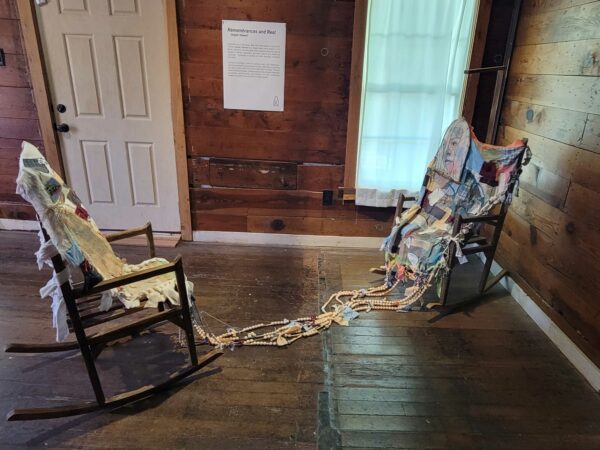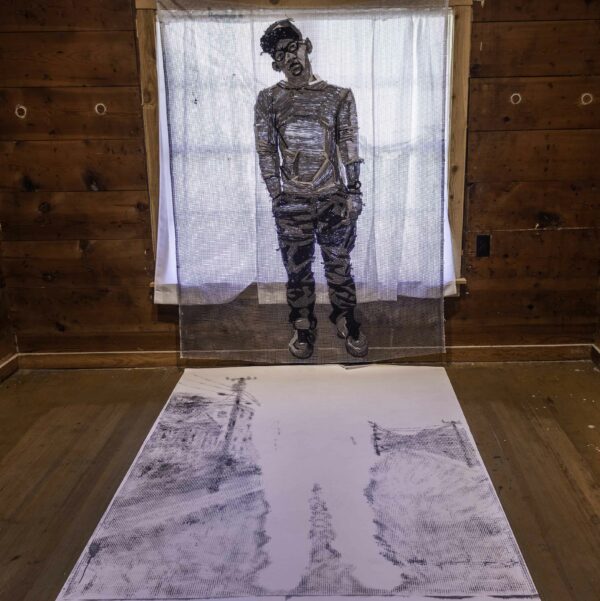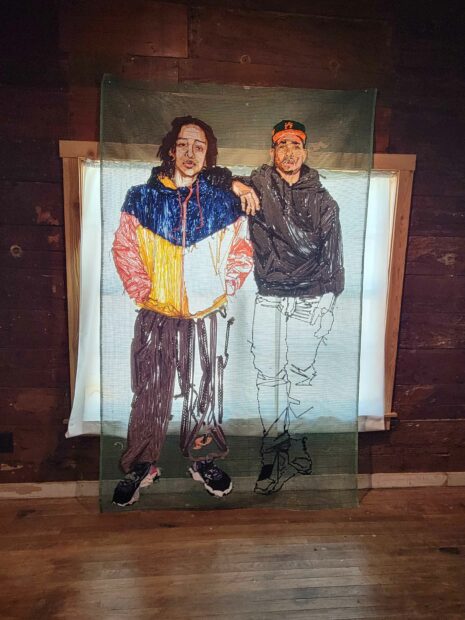Textiles form the fabric of our lives in the most literal sense. From the fabrics that envelop us in the intimate spaces of our homes to the clothing we adorn ourselves with as we navigate the world each day, textiles play a consistent role in life’s many experiences. Woven Together, an exhibition of textile arts at Kinfolk House, allows visitors to reflect on how fabrics can document the stories of people, families, and communities. Featuring three artists’ unique approaches, it offers visitors a greater appreciation for how local, regional, and national artists are transforming a domestic medium into a powerful platform for weaving new stories into our collective history.

Deyjah Stewart, “Help Me Through, Help Me Need You,” 2022, handmade rocking chairs, quilt top, batting, wooden beads, charms, yarn, tracing paper, graphite, acrylic paint, wire, wire hanger, burlap, lettered beads.
Two handmade, wooden rocking chairs serve as the base of Fort Worth artist Deyjah Stewart’s mixed-media installation Help Me Through, Help Me Need You. Fabric pieces arranged in a quilt-like pattern rest almost like figures on the chairs facing each other. The faint sketch of a face peers out from one chair and a silhouette from the other, reinforcing the feeling that this is a scene for two to be engaged in a conversation, inviting viewers to think of the everyday objects that symbolize family, memories, and one’s own sense of self.
In this case, the rocking chairs provide a strong connotation of home. Many families come together in rocking chairs, passing time and sharing conversations or silence. In the context of Kinfolk House, formerly the home of co-founder Sedrick Huckaby’s grandmother, the domesticity Stewart conjures is heightened. Her installation provides the sense that you have just missed this moment. The objects remain, along with a trace of the people, but they have departed and we are left with the memory of their presence.
The maternal theme is quite impactful in Stewart’s installation. Multiple strands of beads extend along the floor connecting the rocking chairs at the seats, reminiscent of an umbilical cord that tethers mother and child. Many mothers and grandmothers have calmed babies with gentle rocking. The maternal theme is further reinforced with the quilted aspects of Stewart’s work. Quilting is a tradition often passed down through families, from mothers, grandmothers, and aunties. It has a long tradition in the African American community as well. Historically, it was an opportunity for creative expression and leisure, in times when Black women were not readily afforded either. There has also been substantial research on the hidden symbols and stories embedded in quilts, some possibly serving as signals along the Underground Railroad.
Quilts are also crafted to celebrate births and provide comfort for those needing care. This notion of care is significant, as Kinfolk House has committed to exploring ideas of self-care and community healing throughout the year, following a partnership with United Fort Worth and ICE Out of Tarrant. How do we foster self-care and community healing in Fort Worth and ultimately the United States as a whole? Stewart’s installations highlight the history of her own family in such an immersive and relatable way. Amplifying these stories of people and families of color, while showing the connections we all share to important objects and moments, is one step forward in this aim.

Deyjah Stewart, “Close to Home,” 2022, yarn, artificial flowers, muslin, wood chips, wooden beads, lettered beads (left) and Isabel Wilson, Collaborative Pieces with Deyjah Stewart, 2022, shirt and pants (right).
As much as Woven Together is a celebration of textile arts, it is also an exhibition centered on collaboration. Isabel Wilson’s collaboration with Deyjah Stewart brings this to the fore. Wilson, a Houston-based fashion designer, partners with visual artists in the creation of textile prints for her eponymous line. Using high-resolution images of the fabrics and objects in Stewart’s Close to Home, Wilson created a textile print that she utilized in her Spring 2023 collection. Items from the collection are on view in the exhibition, along with Wilson’s sketches. The beauty of this project is that neither artist’s voice was muted in the collaboration. Stewart’s artwork was brought to life in Wilson’s signature tier dress and a garment set.
The inclusion of Wilson’s fashions speaks to Kinfolk House’s mission of fostering collaboration, both among artists and between artists and the community. Wilson’s designs bring Stewart’s art about the everyday back into the quotidian lives of people wearing this print. There is also much to be said about the importance of fashion in one’s sense of self. What information do we communicate about ourselves and our history through the clothing we wear? What narratives are formed by others based on our sartorial choices? These questions are further investigated through the third artist in the exhibition, Kandy Lopez.

Kandy Lopez, “Brandon in the city,” 2017, yarn and acrylic on plastic canvas (top) and Kandy Lopez, “Invisible Brandon in the city,” 2017, acrylic on yupo paper (bottom).
Lopez’s Brandon in the city faces viewers with a more than life-sized, grayscale male figure in a hoodie, pants, and sneakers. His head, topped with a cap, tilts to the side and quizzically stares back at viewers through glasses. What is salient about this portrait is not its scale, but its tactility. The figure is constructed with yarn on a sheer, plastic canvas. Installed in front of a window, Brandon springs to life while the painted background, a city block with buildings and powerlines, fades from view like a memory. Laid on the floor in front of the canvas is a yupo paper ghost print titled Invisible Brandon in the city. Lopez placed this sheet behind her yarn portrait of Brandon before spray painting the plastic canvas’ background, leaving a more distinct view of the neighborhood and only the sitter’s outline on this sheet.
The placement of the yupo portrait is confronting. I found myself unsure how to interact with the space, wanting to walk closer to Brandon in the city to closely examine Lopez’s yarn work, but afraid to walk on Invisible Brandon in the city. During her artist talk, Lopez noted this tension and expressed an expectation of footprints on the yupo portrait. These footprints render visible the ways people of color in the United States are trampled on without much attention.
Lopez is a Florida-based artist who has explored portraiture throughout her career. Her works provide striking representations of individuals that hail from the many communities of color found in her hometown of Miami. I was particularly drawn to her works featuring male and/or masculine-presenting subjects, because of the juxtaposition with the “feminine” medium of yarn. Her inclusion of her masculine-presenting cousin, Marly, in several works compels viewers to reassess how they assign gender labels. That extends to the gendering of textile arts and craft. It is crucial to continue the discussion about the association of textile arts with women, and the impact of that association on its estimation (financial and critical) in the fine arts.
Lopez’s works celebrate each individual and their unique expression of identity. However, the compilation of these many portraits tells a bigger tale of the city. You see the many neighborhoods and communities that give Miami its particular style and “swag,” as the artist puts it. Although the national artist in this exhibition, Lopez’s contribution, titled Power Poses, reminds viewers to take time and consider the many neighborhoods and communities that comprise Fort Worth. Truly, it is beautifully aligned with the mission of Kinfolk House, to highlight the contributions of the Polytechnic community and, as an extension, the many communities of color in Fort Worth.
Woven Together showcases the exceptional creations of three textile artists and their explorations of how we are all connected: as families, collaborators, and communities. When viewing this exhibition, one cannot help but consider how the many common moments of life form a narrative and ultimately one’s history. Kinfolk House is taking an active role in helping us expand our collective history to be more inclusive of communities that have, traditionally, been marginalized.
Woven Together is on view at Kinfolk House in Fort Worth through April 22, 2023.




